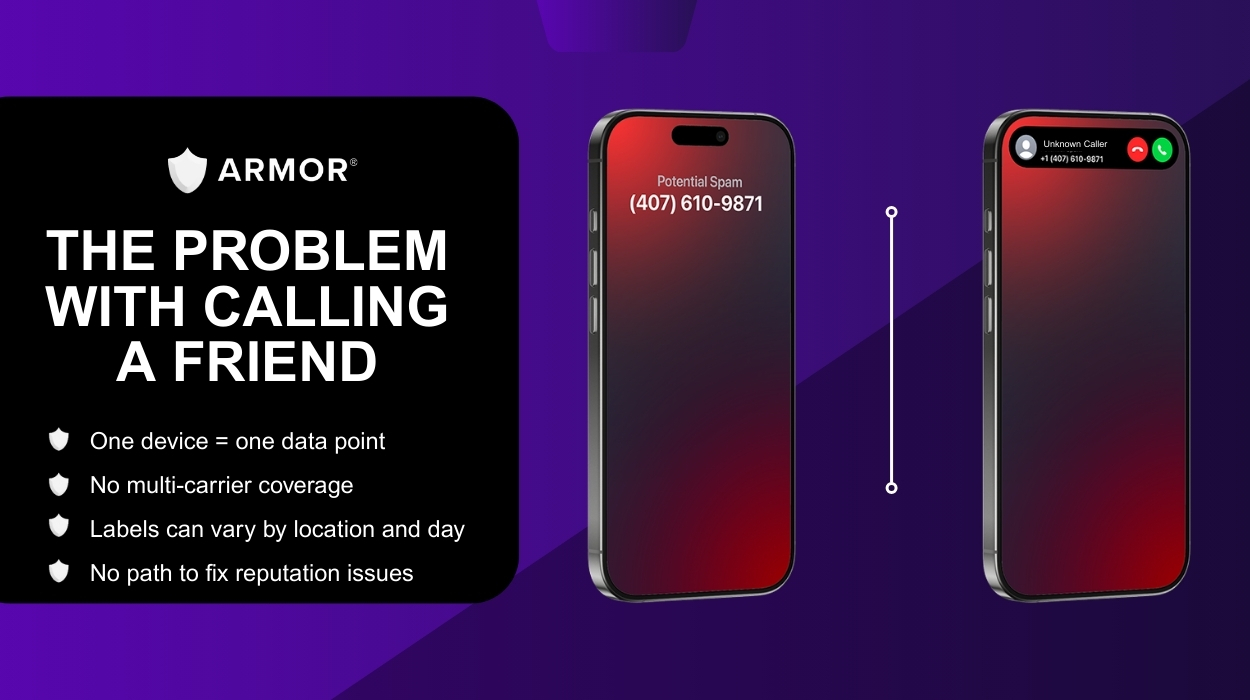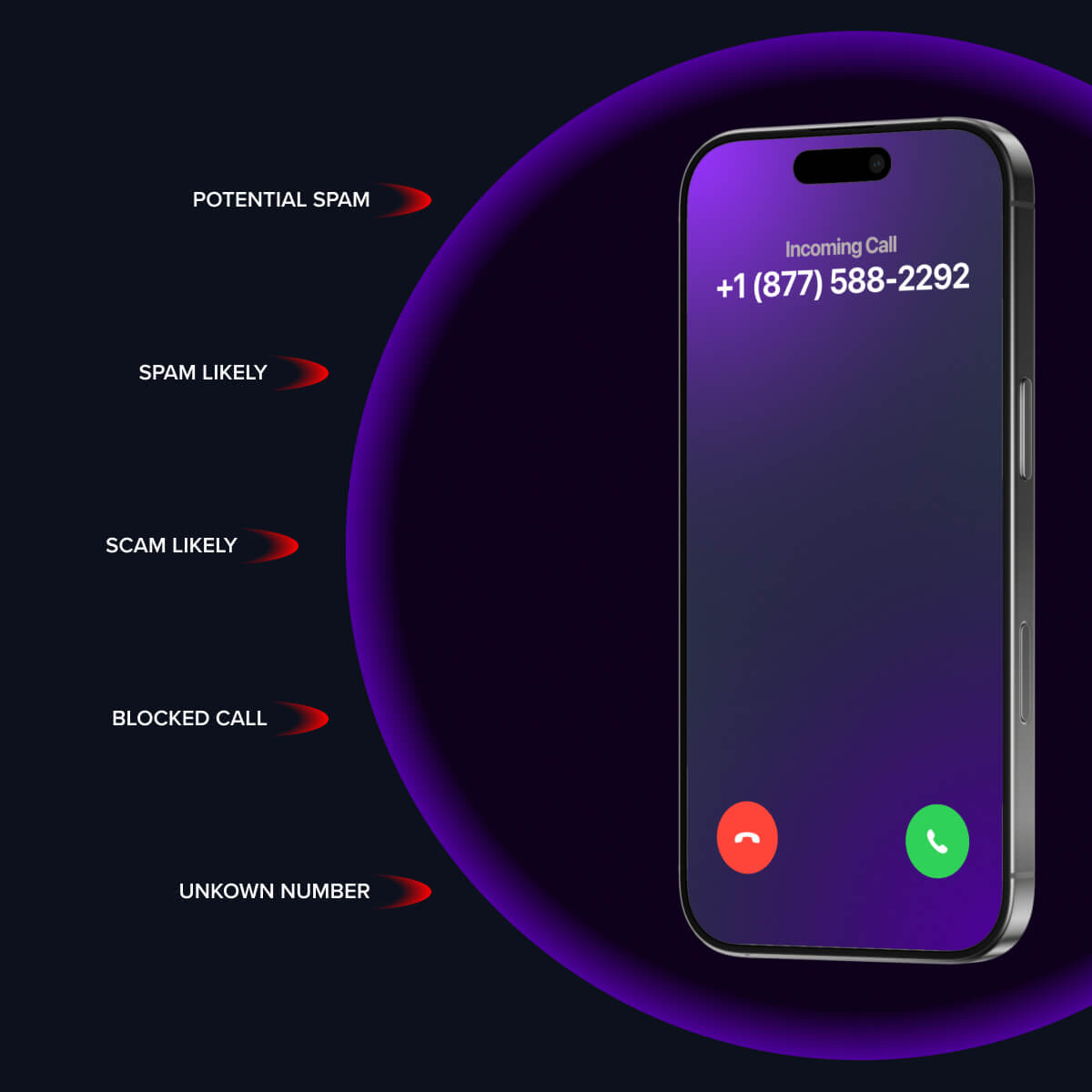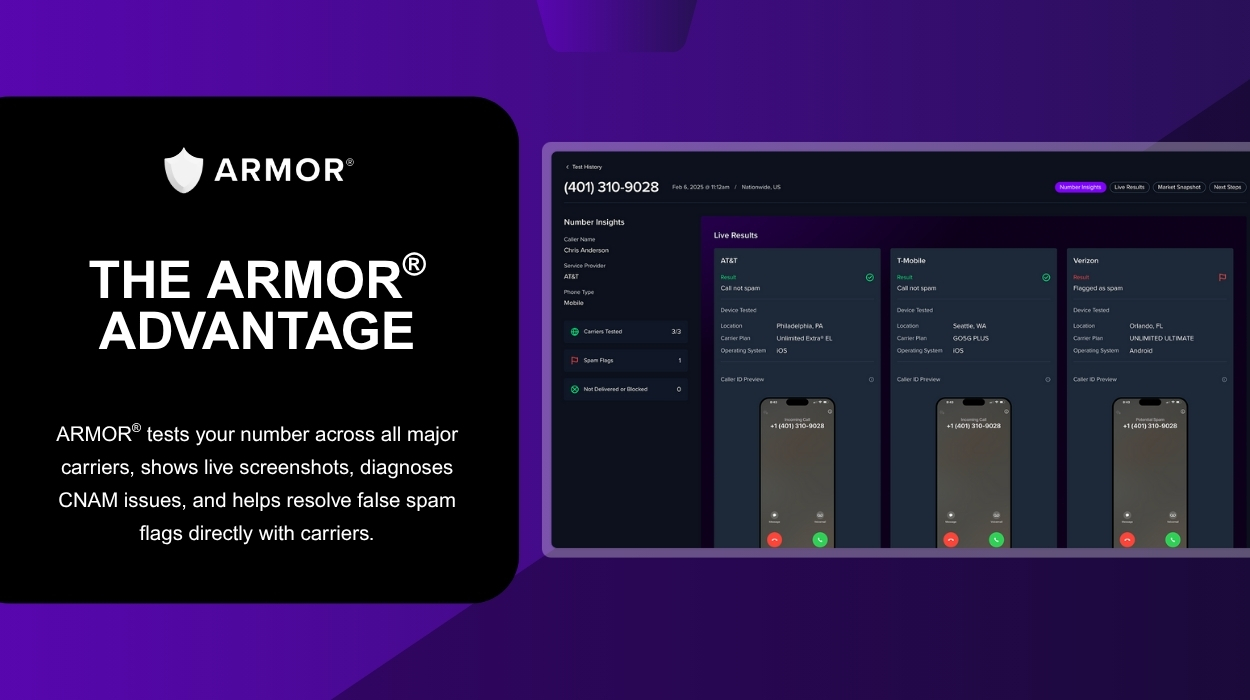
Negative Caller ID reputation can destroy answer rates if your number consistently shows up as “Scam Likely” or “Spam Risk.” While some teams test by calling a friend or using basic spam checkers, these methods give incomplete or unreliable results. ARMOR® provides a clearer alternative with carrier-specific testing, real-time data, and direct remediation of false flags. By monitoring and resolving reputation issues this method can help ensure your calls connect and your team’s effort isn’t wasted.
Outbound calls only work if someone actually picks up, but problems with your caller ID reputation can tank your answer rates before you even get a chance to talk.
If your number is mislabeled as “Spam Likely” or “Scam Risk,” all that effort your team puts into prospecting and dialing is being wasted.
Testing your phone number is the best way to avoid false spam flags, but how you test matters. Many teams mistakenly believe that calling a friend is a reliable way to check how their numbers are displaying. Others put their trust in basic spam checker tools that use bots or simulated calls to test numbers, or which may only provide limited data. More sophisticated teams use solutions that rely on live human testers and provide deeper analytics like location-specific results to quickly monitor, diagnose, and resolve number reputation problems.
Below, we explore each approach, along with their pros and cons. We’ll also walk you through a real-world scenario that shows where calling a friend breaks down and why we designed ARMOR® to fill the gaps.
Before we dig into the methods, it’s worth remembering why this matters.
81% of businesses report lost revenue due to spam flags. That’s not a minor annoyance. It’s a fundamental obstacle to overall business success.
Caller ID labels are determined by a complex ecosystem of carriers, analytics providers, and apps. It’s never down to just one device.
Labels can also change in real time based on volume patterns, call duration, complaint reports, and more.
This is why you can’t just choose not to test your numbers. Testing is how you can understand how prospects actually see you, and whether your calls have a chance of connecting.

The simplest way to test your number is to dial a friend, family member, or colleague and ask them what shows up on their screen. But being simple is rarely the same as being the best, and that’s especially true here.
Here’s what you get with this method, and more importantly, what you don;t:
So calling a friend gives you a snapshot in a single mirror, but there are hundreds of mirrors around you and most remain unseen.

There are several third-party spam checker tools designed to test numbers across a handful of carriers and show whether a number is labeled as spam. However, these tools range in terms of their quality, detail, and overall value.
Spam checkers are better than nothing, but many fall short of the actionable insights you need to strengthen number reputation long-term and protect revenue.

Unlike calling a friend or relying on a basic spam checker, ARMOR® is designed specifically to give you a trustworthy, actionable view of how your calls appear, and it can help you fix problems at the source.
This can go beyond simply testing your numbers to deliver an entire layer of protection for your number reputation.
Where the first two methods give you some level of data, ARMOR® provides consistent, enterprise-grade visibility and remediation. You get a clear picture. No more guesswork.
To see the difference more clearly, let’s walk through a realistic situation.
Your SDR team notices that connect rates dropped sharply yesterday. Normally, your reps connect with 15% of dials. Now, it’s closer to 9%. You suspect caller ID reputation issues and want to test your main outbound number.
To assess if your number is flagged, you dial Jordan, who uses Carrier A. Jordan sees your business name, “Acme Corp.” so you assume things are working as normal.
You continue to make calls. Unfortunately, your connect rates are still degraded, leaving you wondering what’s going on.
Imagine this scenario instead:
You run an ARMOR® number test. Instead of calling a friend or coworker, ARMOR® places live test calls to real subscribers across all major carriers and locations.
Within minutes, you have results from real Verizon, T-Mobile, and AT&T customers, complete with screenshots of how your calls displayed on their phones.
The results show:
You now have a clearer understanding of what’s going on. Your calls are displaying incorrectly on Carrier C, which could impact answer rates as well as number blocks. You’re flagged on Carrier A, but you know at least that it’s limited to one carrier, signaling a potentially isolated issue.
From here, the path forward is clearer. With some peace of mind that the flag isn’t widespread, you can consider continuing to dial, exhibiting healthy call patterns in hopes that the isolated flag comes off on its own (this will often happen as healthy and consistent call patterns emerge).
Subsequent tests can help confirm whether the flag has been resolved or if you should pause the use of the number in question and enter remediation with the specific carrier impacted.
If you are an ARMOR® customer, your numbers receive ongoing monitoring, and our team will work with impacted carriers to identify and remediate false flags on your behalf without you having to ask.

When you use a high-quality spam checker, you benefit in several notable ways.
ARMOR’s best-in-class number tester delivers:
With full ARMOR protection you also receive:
At the end of the day, testing isn’t just about knowing whether your number shows up as “Spam” at one point in time, on one device. It’s about building a stronger number reputation that powers long-term results, having an accurate, actionable picture of your caller ID reputation across the networks that matter—and tackling issues head-on before they drain revenue.
ARMOR® gives you:
When the difference between a prospect picking up and ignoring or blocking your call is worth hundreds, thousands or more in pipeline, relying on a quick “call a friend” test just isn’t enough.
Don’t leave your contact rate to chance. Test and protect your numbers the right way.
Get a demo of ARMOR® today and see how your calls are showing up across networks. Then trust us to help you fix any issues you’re having before they cost you business.